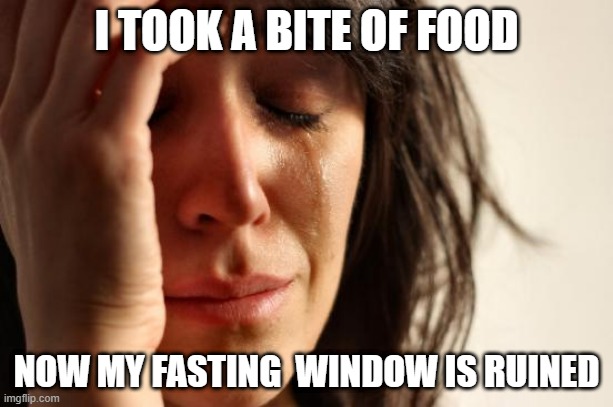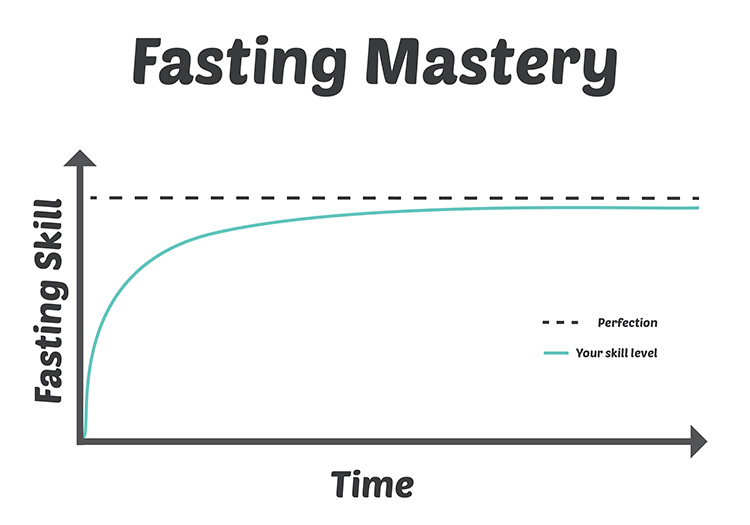An important thing to understand about intermittent fasting is that you’re not perfect. You will, because you are an imperfect human living in an imperfect world, get off track from time to time.
Sometimes the reason you get off track will be because you made an honest mistake. Other times it will be because you went off plan on purpose; you had a plan but changed it with intention. And sometimes, you will rebel.
No matter why you got off track, the key is to get yourself back on it. That is easier said than done. The good news is, there are strategies that can help you get past the guilt and frustration and pick up where you left off. Let’s start with the most common way fasters get off track: the accidental bite.
When You Take a Bite When You’re in the Fasting Window
It’s happens all the time. You’re bopping through the living room and you see your toddler left a bite of her PB&J on her plate. You pop it into your mouth and don’t think a thing about it. The food has already hit your stomach before you realize you were supposed to be fasting.

Once the first bite happens, it becomes a mental game. If you believe that you’ve broken the fast, then what’s one more bite, or three? The thing to remember is that one bite is not fatal. In fact, one bite will not make a hill of beans worth of difference. What matters is how you think about that one bite of food.
If you think one bite means you’re weak, or that you’re a failure, or that you’re doomed to gain weight, you’re heading for trouble. That kind of thinking will lead to more and more bites, and possibly emotional eating, which will lead to weight gain.
That one bite means you’re human. You either forgot, or maybe you didn’t really forget. It doesn’t matter. Intermittent fasting works as a weight loss strategy because it helps you to more easily consume the correct amount of food. Taking a single bite will not, in the big scheme of things, matter. The only way it will matter is if it leads you to overeat.
If you take a bite, the way to recover from it is to stop at that one bite. You must keep yourself in the game mentally. The goal here is to eat less food. You took a bite. Learn from it, and move on.
Breaking The Fast Early
But sometimes it’s not just one bite. Sometimes you’ll truly break your fast early. There are many reasons this will happen. If you’re a beginner intermittent faster, this will probably happen because you’re hungry.
Many new fasters try to leap to a longer fasting window in the hopes of kick-starting their weight loss. Let’s take a fictional faster, Hurrying Harriet. Harriet just weighed for the first time yesterday and she realized she has 50 pounds to lose, and she wants to lose it fast. Her current habit is to eat breakfast, nosh throughout the morning, and then have lunch. She usually has a few bites here and there in the afternoon, a good sized supper, and then snacks in front of the tv with her husband Earl. But now she’s decided she’s going to do a 18:6.
When Harriet wakes up, she goes to the fridge out of habit, but catches herself before she eats anything. Her stomach growls at her because she skipped her late-night snack with Earl. She wanders aimlessly around the kitchen for a while and then flips on the tv. By around 10 am, she’s feeling nauseous, but she hangs in there. At 11 am, she goes for a walk. She just needs to make it to 2 pm, but when she gets back into the house at noon, the idea of waiting two more hours is too much. She eats.
If Harriet is the typical beginner faster, she will take one of two paths: overcompensation or quitting.
Overcompensating
Let’s look at how Harriet might overcompensate. She might mentally berate herself for being so weak as to break the fast early. She might ask herself why she can’t just have more self-control. And then she’ll vow to herself that tomorrow she’ll fast for 20 hours to make up for breaking the fast early today.
The next day, because of her guilt and mounting frustration, added to an unreasonable expectation of how long she should be able to fast, she only makes it to 12:30. Instead of seeing that as progress, she’ll likely frame it as utter failure. This will lead to more guilt, less motivation, and eventually outright quitting. This is not good.
Quitting
Or Harriet might skip the overcompensating phase and go straight to quitting. She tried fasting for one day. Instead of considering that perhaps she was being too aggressive and expecting too much of herself, she beats herself up mentally. She wakes up the next day and just doesn’t have the heart to try again. She goes back to eating all day, convinced she’s not capable of fasting.
How To Recover From Breaking The Fast Early
Don’t be a Hurrying Harriet. If you break your fast early for any reason, don’t let it mess with your head. Just get back on plan ASAP. The first step is to keep this all in the proper perspective. Here are some tips:
- Keep your self-talk encouraging. No trash talking allowed.
- Focus on how long you fasted instead of how short you fell.
- Remind yourself that you’re learning how to fast. Learning means making mistakes.
- Remember that weight loss occurs when you eat the right amount. The fasting window simply facilitates this.
To get good at fasting, you must practice. And to practice something, you need to stick with it. To increase your odds that you’ll stick with it, try to stay in the goldilocks zone. Aim for feeling challenged, but not so much that you break. Don’t pay attention to how fast other people got to a 16:8 or to OMAD. You are an individual. Here are two possible paths forward.

Strategy #1: Work Your Way to A Longer Fasting Window
If you’re currently in the habit of eating all day long, or if you keep breaking your fast early, commit to a short fasting window. Even fasting from 10 pm to 6 am is a good place to start. Sure, you’ll be sleeping through it. That still counts. You’re learning how to have boundaries with food.
When you feel ready, push breakfast to 6:15 or 6:30 instead of 6. And after you do that for a while, push breakfast a little later. Keep the difficulty level in that goldilocks zone. If you do this, you’ll be stacking up victories every day. This helps you stay in a positive place mentally, which is vital.
If you stick with this, you’ll eventually find yourself at a 16:8, or maybe even a 18:6. You’ll rarely break the fast early, and when you do, it’ll most likely be because you’re doing it intentionally for reasons other than hunger. Going slower leads to better consistency.
Strategy #2: Set a Schedule
But let’s assume for a moment you’ve decided that you aren’t interested in going slowly. You want to jump to a 16:8. This can work, as long as you realize that your consistency will probably be spotty at first, and you’ll probably also be dealing with a lot more hunger. Fasting will feel more difficult than it would have felt if you had gone more slowly with it.
The best strategy is to keep your fasting windows the same each day. For example, when you’re doing a 16:8, eat from 11 am – 7 pm. Or 10 am – 6 pm. Do whatever works for your life. If you need to break it early, keep your closing window the same. Conversely, if plans make it so that your window needs to close later, let it close later, but keep your opening window the same the next day. Yes, that means your fasting window would be shorter the next day, and that’s okay.
Even if you go with strategy #1, it’s still a good idea to keep your schedule the same once you find the fasting window that works for you. Keep your fasting life as simple as possible. If you keep your windows the same each day, you’ll always know whether you should be eating. (Side note: if your schedule is extremely variable, intermittent fasting can still work for you. Look at this interview I did with my brother, Roger Cox, to see how flexible this way of eating can be.) It takes a mental load off, and it increases your odds of success. When you’re not distracted by constantly recalculating windows, you can focus on how much you’re eating. This is what will get the pounds off your body.
What Typical Beginning Fasting Looks Like
But what does this look like in real life? Let’s go back to Harriet and her attempt at an 18:6. We’ll assume she’s stubborn and doesn’t want to crawl before she walks. She wants to attempt an 18:6 each day. Here’s what her path might look like if she was trying to eat between the hours of 2 pm – 8 pm:

- Monday: Broke fast early at noon, closed fasting window at 8 pm
- Tuesday: Broke fast at 12:30, closed fasting window at 8 pm
- Wednesday: Stuck to schedule
- Thursday: Broke fast early at 11 am, closed fasting window at 8pm
- Friday: Broke fast at 2 pm, but snacked with Earl until 10 pm
Yes, that looks messy. No, Harriet is not being perfect. But if Harriet will stick with this for a few weeks, and work on getting a little better each day, her consistency will improve. And when she gets more consistent, her self-discipline will increase, which can lead to her eating the right amount. The hard part is practicing intermittent fasting consistently, even when you’re not losing weight yet. If you aren’t losing yet, it can be very difficult to get motivated to get back on track if you ever make a mistake.
When Will You Start to Lose Weight With Intermittent Fasting?
Weight loss will only occur when the amount of food you are consuming is less than what you are burning. If you eat less than your body needs, even when you’re breaking the fast earlier than you intended, you’ll lose weight. Likewise, you will gain weight on a 20:4 if you eat more calories than your body needs, even if you’re extremely consistent.
You might get consistent with a 14:10 and find that your weight drops. You might get to a 20:4 before you see progress. It all comes down to how much you’re eating each day. Some people eat the right amount in a shorter window, other people find they have more self-control with a longer window.
Bottom line: don’t give up if you get off track. Learn from it. Try again. Experiment and find what works for you.
